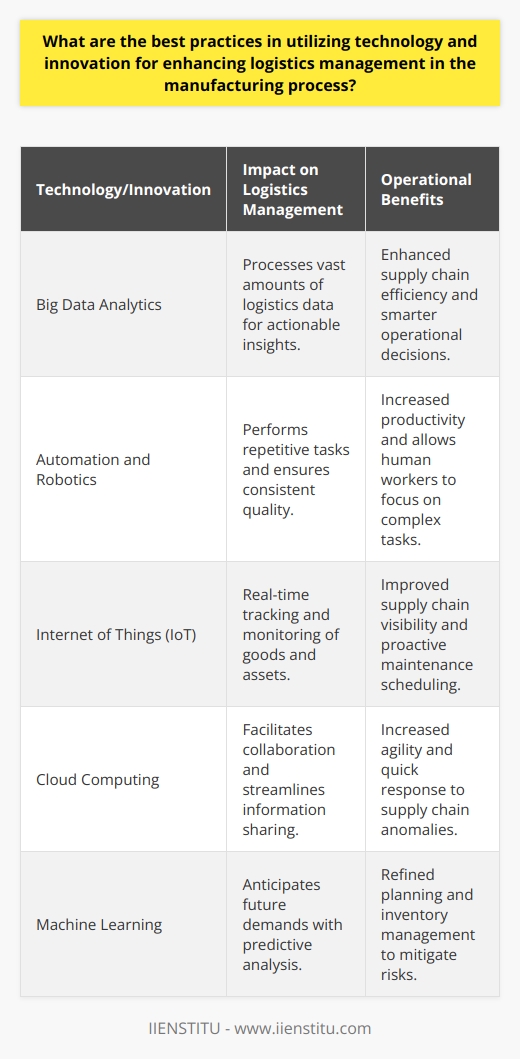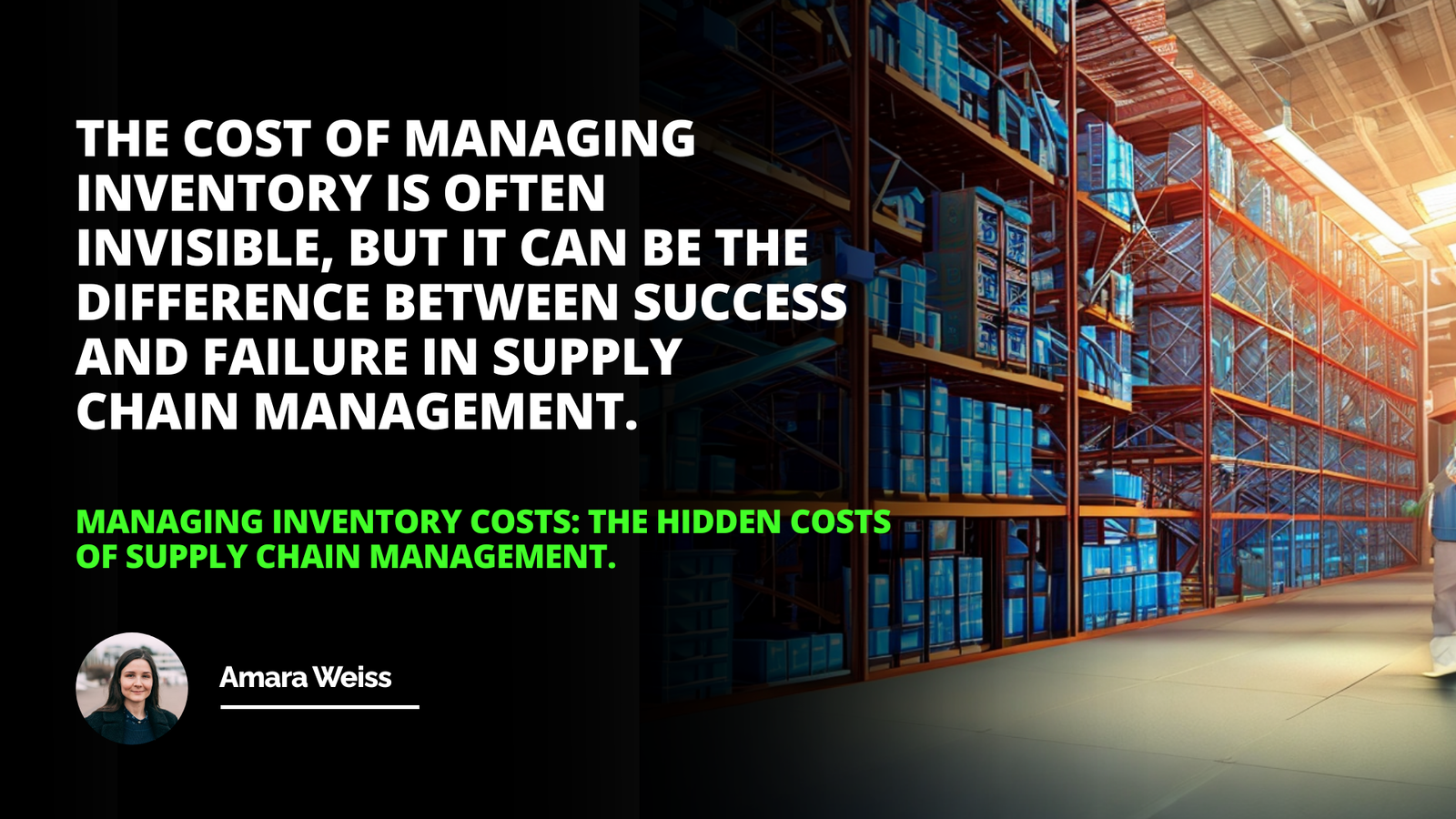
Process Logistics is a type of logistics concerned with the movement of in-process or work-in-progress inventory for the production of goods. It helps prepare production scheduling and ensures that the right parts and components are available at the right place and time. It also takes care of inventory movement for the internal customer's requirements. An example of its use in manufacturing is the production of trucks.
Introduction
What is Process Logistics?
What Does Process Logistics Do?
Example of Process Logistics in Manufacturing
Conclusion
Introduction: Process Logistics is an essential part of the manufacturing industry and plays a vital role in producing goods. It involves the movement of in-process or work-in-progress inventory and helps prepare production scheduling. This article will discuss what Process Logistics is, what it does, and provide an example of its use in manufacturing.
What is Process Logistics?
Process Logistics is a type of logistics concerned with moving in-process or work-in-progress inventory. It involves transporting parts and components from decentralized locations to the main plant to assemble products. Process Logistics also manages the movement of stock for internal customer requirements.
What Does Process Logistics Do?
Process Logistics help in preparing production scheduling. It ensures that the right parts and components are available at the right place and time. It also helps to ensure that the inventory is available for the products to be manufactured. Process Logistics also takes care of the movement of stock for internal customer requirements, where the degree of uncertainty is shallow because the manufacturing operations are under the control of management.
Most Searched Keyword About The Key İmplications Of The Bill Of Lading İn Business Transactions
Most Searched Keyword For Decoding Supply Chain Systems Perspective
Example of Process Logistics in Manufacturing
An example of Process Logistics in manufacturing can be seen in the production of trucks. The sub-assemblies for the car will be manufactured at the decentralized locations from where these have to be brought to the main plant for carrying out the main truck assembly. Process Logistics ensures that the right parts and components are available at the right place and time for the truck's body.
Conclusion: Process Logistics is an essential part of the manufacturing industry and plays a crucial role in producing goods. It involves the movement of in-process or work-in-progress inventory and helps prepare production scheduling. Process Logistics also takes care of the movement of stock for internal customer requirements, where the degree of uncertainty is shallow because the manufacturing operations are under the control of management.
An example of Process Logistics in manufacturing can be seen in the production of trucks. Process Logistics ensures that the right parts and components are available at the right place and time for the car's assembly.
Optimizing logistics management in manufacturing is the key to achieving operational efficiency.
Related Course: Logistics Training
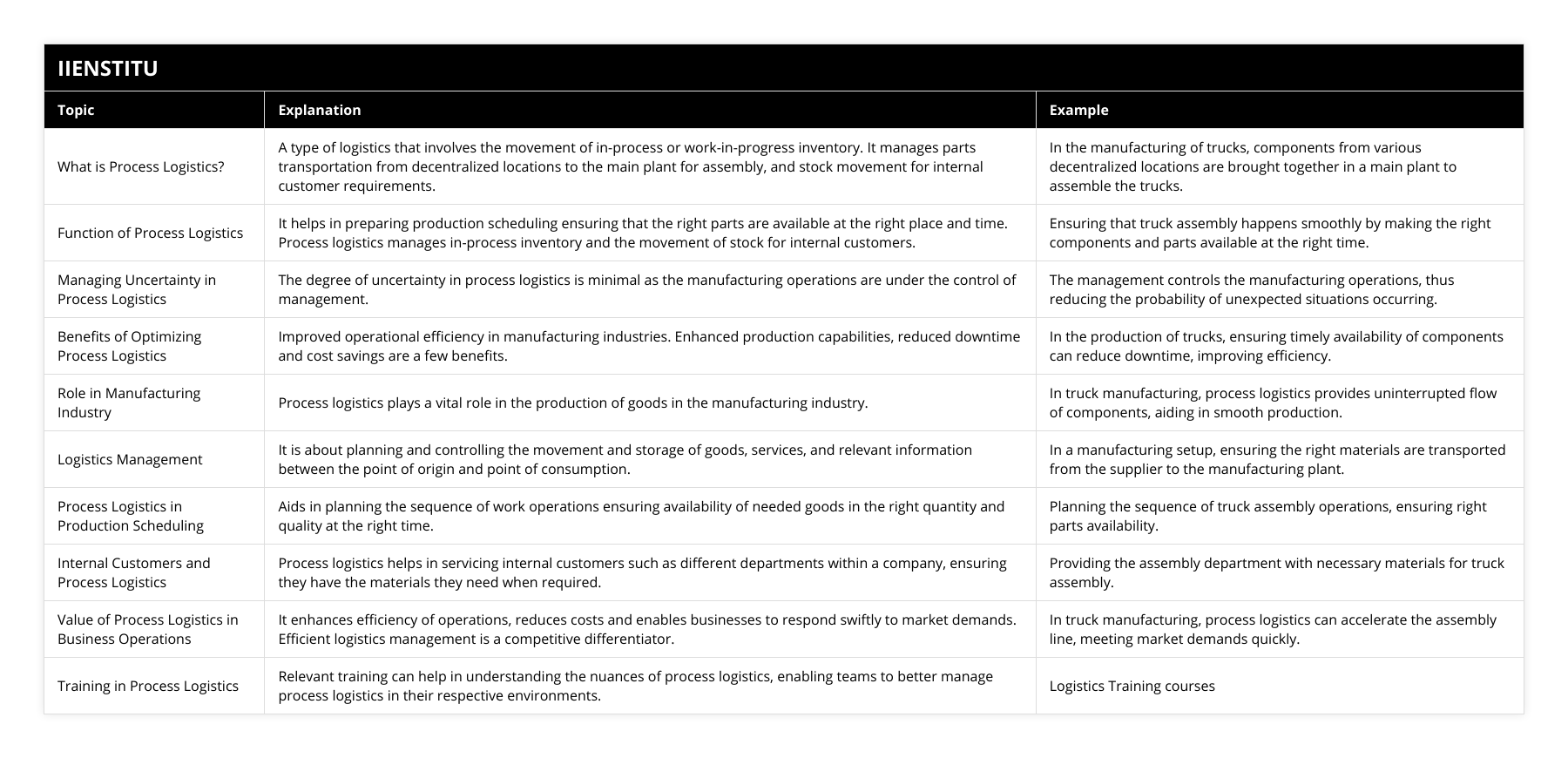
Frequently Asked Questions
What are the benefits of optimizing logistics management in manufacturing?
Logistics management is an essential part of the manufacturing process. It involves the efficient movement of materials and products from one place to another, from manufacturing to consumption, or from production to distribution. By optimizing logistics management in manufacturing, companies can enjoy various benefits.
One of the main benefits of optimizing logistics management in manufacturing is improved operational efficiency. Companies can save time and money by reducing unnecessary costs and delays associated with inefficient logistics practices. By utilizing the correct method and technology, companies can streamline their processes and reduce the time and cost associated with the movement of goods. Furthermore, efficient logistics management can help reduce inventory levels, thus leading to cost savings and improved customer service.
Another benefit of optimizing logistics management in manufacturing is increased customer satisfaction. By improving the speed and accuracy of the delivery of goods, companies can provide a better customer experience. This can result in increased loyalty, brand recognition, and improved customer service ratings. Additionally, optimizing logistics management in manufacturing can reduce the risk of overstocking and understocking, ensuring that customers always have access to the products they need.
Finally, companies can improve their environmental performance by optimizing logistics management in manufacturing. By utilizing green transport technologies and reducing wasteful packaging, companies can reduce their carbon footprint and positively impact the environment. Furthermore, efficient logistics management can help reduce the waste generated, leading to a more sustainable manufacturing process.
In conclusion, optimizing logistics management in manufacturing can provide various benefits to companies, such as improved operational efficiency, increased customer satisfaction, and improved environmental performance. By utilizing the correct methods and technologies, companies can streamline their processes and reduce costs while providing a better customer experience. Additionally, companies can reduce their environmental impact by utilizing green transport technologies and reducing wasteful packaging. As such, optimizing logistics management in manufacturing is an essential part of the manufacturing process.
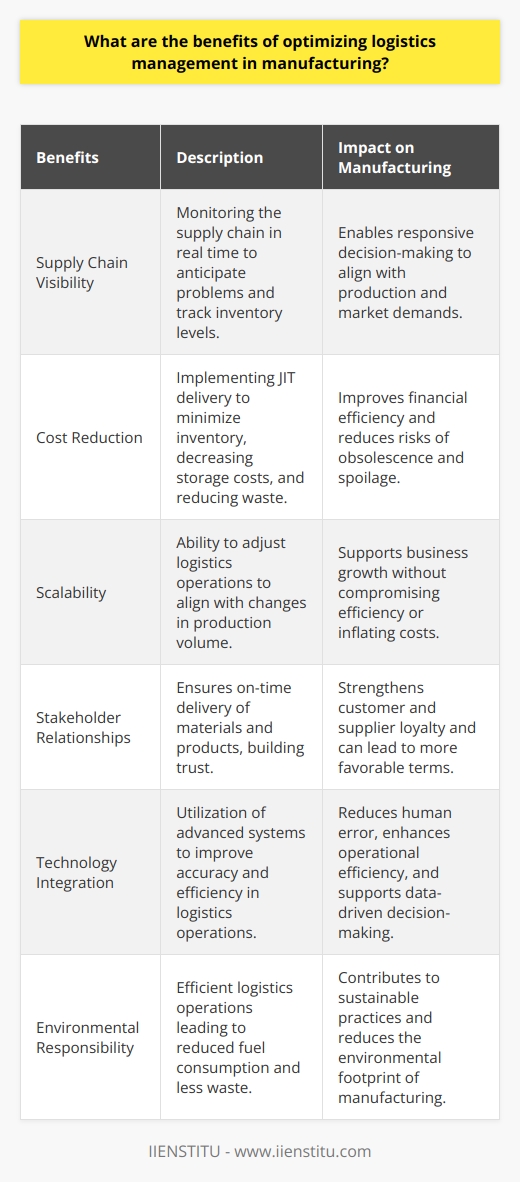
How can process logistics be used to improve efficiency in manufacturing?
Process logistics is an essential part of a successful manufacturing operation. It involves organizing, controlling, and optimizing the resources and activities required to produce goods and services. Understanding how to process logistics can be used to improve efficiency in manufacturing.
The first step in using process logistics to improve efficiency in manufacturing is to identify the processes that need to be improved. This includes analyzing the current process and understanding where there are inefficiencies or opportunities for improvement. Once the process has been identified, it is essential to identify the resources and activities required to optimize it. This includes the equipment, personnel, materials, and other necessary resources to achieve the desired outcome.
Next, it is essential to create a process flowchart. This will help to visualize the steps in the process and identify any potential bottlenecks and areas for improvement. After the process flowchart is created, developing a plan for improving efficiency is essential. This can include streamlining processes, new technologies, or new methods for tracking and measuring performance.
Once an improvement plan has been developed, it is essential to implement it. This can include training personnel, procuring new technologies, and developing new processes. Additionally, it is necessary to monitor the plan's implementation, as this will help identify areas for further improvement and any potential issues that could affect the efficiency of the process.
Finally, it is essential to continually monitor the performance of the process and make adjustments as needed. This can include introducing new technologies or processes or new measures of performance. By continually monitoring the process, it is possible to identify areas for further improvement and ensure that the process is as efficient as possible.
In conclusion, process logistics is essential to a successful manufacturing operation. By understanding how it can be used to improve efficiency in manufacturing, it is possible to increase the efficiency of the process and reduce costs. Additionally, process logistics can help to ensure that the process is as efficient and cost-effective as possible.

What strategies can be employed to ensure effective implementation of process logistics in manufacturing?
Process logistics is a critical area of operations for any manufacturing process. It involves planning, coordinating, and managing resources to ensure production runs efficiently and cost-effectively. Therefore, implementing effective process logistics is essential for the successful and timely delivery of goods and services. In this blog post, we discuss some strategies that can be employed to ensure the effective implementation of process logistics in manufacturing.
The first step in implementing effective process logistics is clearly defining the process's objectives. This requires thoroughly analyzing the current process and carefully considering the desired outcomes. Next, it is essential to identify the specific goals of the process, such as the cost, time, and quality of the product or service. Once these goals have been established, the next step is to create a plan to achieve them. This plan should include the resources needed, the timeline for each step, and the metrics used to measure progress.
Another essential aspect of process logistics is the selection of appropriate tools and technologies. Choosing the right tools and technologies to support the process's objectives is necessary. For example, computer-aided design (CAD) software can facilitate the design and manufacturing process, while enterprise resource planning (ERP) systems can improve visibility and traceability. The use of data analytics can also help to identify areas for improvement and optimize the process.
The third step in implementing effective process logistics is to ensure that the right personnel is in place to carry out the process. This means recruiting, training, and retaining the right people with the right skills and experience. Communication and collaboration among team members are also essential for successful process logistics. The fourth step is ensuring the process is monitored and tracked correctly. This requires setting up the right kind of systems and processes to monitor the performance of the process. This can involve tracking the time taken to complete tasks, the quality of the output, and any bottlenecks or delays.
Finally, reviewing and adjusting the process regularly is essential to ensure it continues to meet its objectives. This could include making changes to the tools and technologies used or introducing new techniques or procedures. It is also essential to review the performance of the personnel involved in the process and make changes as necessary.
In conclusion, effective process logistics is essential for the successful and timely delivery of goods and services. By following these strategies, manufacturers can ensure that their process logistics are correctly implemented and managed.
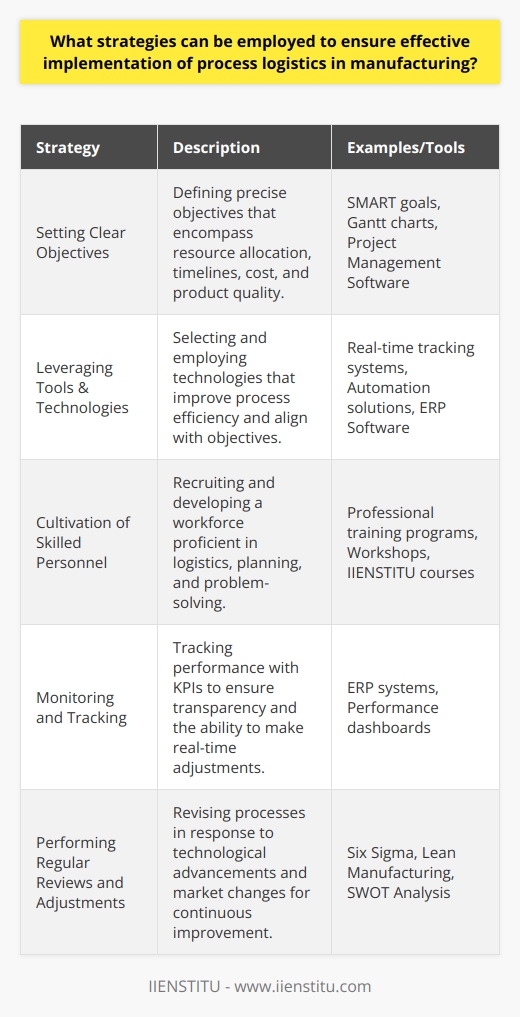
What is the role of manufacturing logistics management in reducing lead times and improving production efficiency?
Role of Manufacturing Logistics Management
Lead Time Reduction
Manufacturing logistics management plays a crucial role in reducing lead times by streamlining the flow of goods and information throughout the production process. It ensures that vital resources, such as raw materials, components, and finished goods, are delivered to the appropriate locations on time. Effective logistics management also contributes to mitigating risks and uncertainties in the supply chain, which can directly impact delivery times.
Enhanced Production Efficiency
By optimizing transportation, warehousing, and inventory management processes, manufacturing logistics management significantly improves production efficiency. As a result, resources are utilized optimally, and waste or redundancy is minimized, leading to reduced production costs. Furthermore, implementing real-time monitoring and control systems enables rapid decision-making and faster response times, thereby increasing overall manufacturing performance.
Collaboration and Integration
In order to effectively reduce lead times and improve production efficiency, manufacturing logistics management must foster collaboration and integration among various stakeholders in the supply chain, such as suppliers, carriers, and customers. This can be achieved via tools like electronic data interchange (EDI), enterprise resource planning (ERP) systems, and advanced analytics platforms that allow for seamless communication, information sharing, and increased visibility across the entire supply chain ecosystem.
Forecasting and Planning
An integral part of manufacturing logistics management involves using data analytics and forecasting techniques to predict future demand patterns, allowing organizations to plan their production schedules more accurately. Accurate demand forecasting and production planning enable companies to reduce lead times and optimize inventory levels, which translates into lower carrying costs and increased customer satisfaction.
Continuous Improvement
Finally, adopting a continuous improvement mindset in manufacturing logistics management is essential in driving innovation, eliminating inefficiencies, and sustaining organizational competitiveness. Techniques such as lean manufacturing, Six Sigma, and total quality management (TQM) can be implemented within the logistics function to identify areas for improvement, set goals and objectives, and measure performance against these targets.
In conclusion, manufacturing logistics management plays a pivotal role in reducing lead times and improving production efficiency. It does so by optimizing logistics processes, fostering collaboration and integration, leveraging data analytics for forecasting and planning, and embracing a continuous improvement culture. As a result, companies can meet customer demands more effectively, adapt to market changes, and stay ahead in a competitive global environment.
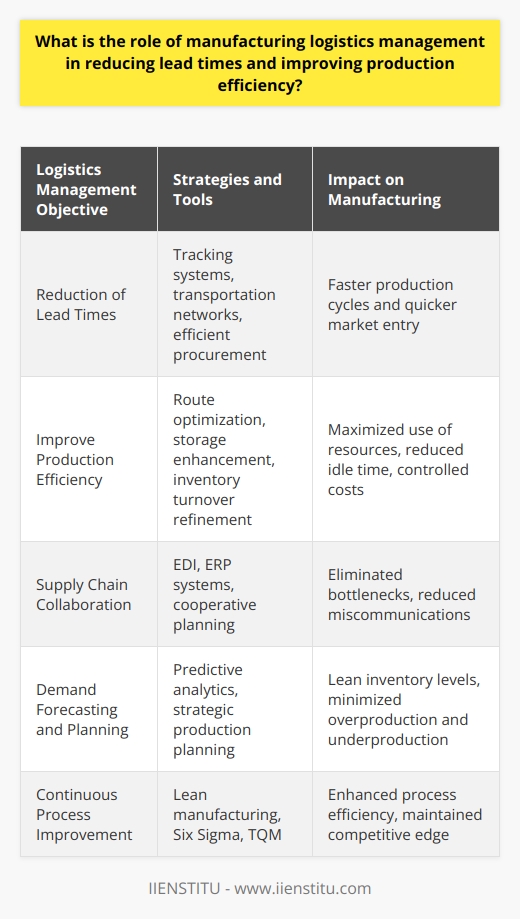
What are the key components of optimizing logistics that can lead to enhanced productivity and cost reductions in manufacturing operations?
**Efficient Inventory Management**
A critical component for optimizing logistics in manufacturing operations is efficient inventory management. Implementing systems that accurately track raw material and finished goods stocks can significantly improve productivity and reduce costs. By ensuring that inventory levels are properly maintained, manufacturers can prevent stock shortages, reduce delivery delays and minimize stock holding costs, thus contributing to improved financial performance.
**Optimized Transportation**
Another vital aspect of optimizing logistics is transportation. Streamlined transport processes, including effective carrier selection, route planning, and capacity utilization, can reduce transportation costs and facilitate on-time delivery. Collaboration with transport partners and the use of shipment tracking systems can improve coordination and allow for timely adjustments to transport schedules. Proper transportation management can lead to enhanced overall productivity and reduced operational expenses.
**Warehouse Optimization**
An efficient warehouse is crucial for optimizing manufacturing logistics. By implementing warehouse management systems (WMS) and automating processes, manufacturers can improve order accuracy and reduce picking and packing errors. Furthermore, effective warehouse layout design and space utilization can reduce handling times and increase throughput. Warehouse optimization contributes to cost reductions and increased productivity in manufacturing operations.
**Advanced Technologies Integration**
Incorporating advanced technologies, such as the Internet of Things (IoT), artificial intelligence (AI), and robotic process automation (RPA), can significantly enhance logistics optimization. These technologies can provide real-time visibility into operations, allowing manufacturers to monitor performance and proactively address potential issues. Additionally, AI-driven analytics can enable data-driven decision-making, identifying opportunities for improvements, and predicting future demand patterns.
**Supply Chain Visibility and Collaboration**
Enhancing supply chain visibility and fostering collaboration among stakeholders is vital for optimizing manufacturing logistics. By creating transparent and integrated supply chains through the sharing of data between suppliers, manufacturers, and customers, companies can gain better control over their operations, identify bottlenecks, and uncover areas for improvement. This visibility and collaboration lead to increased efficiency, reduced lead times, and lower cost-per-unit production.
In conclusion, optimizing logistics in manufacturing operations involves a combination of efficient inventory management, streamlined transportation processes, warehouse optimization, advanced technology integration, and supply chain visibility and collaboration. These key components are instrumental in enhancing productivity and achieving significant cost reductions in manufacturing.

Can you explain the 5 most commonly known principles to improve logistics and their implementation in a manufacturing context?
**Efficient Transportation**
Transportation plays a vital role in optimizing logistics efficiency. The most common approach for manufacturers is to decrease transportation costs by consolidating shipments, selecting the best carriers, and forming strategic partnerships. Additionally, a proactive transportation management system that accurately tracks and analyzes data on delivery times, costs, and routes can significantly improve decision-making and reduce unnecessary expenses.
**Inventory Management**
Effective inventory management can help reduce costs, improve customer satisfaction, and increase overall productivity within a manufacturing setting. Manufacturers should deploy real-time inventory tracking systems capable of providing accurate data on stock levels and movements. Additionally, implementing a just-in-time (JIT) inventory approach, which reduces lead time and minimizes safety stocks, can further optimize the inventory management process.
**Warehouse Optimization**
The efficient use of warehouse space is essential for manufacturers to maximize storage capacity and streamline material handling. Implementing proper storage systems, such as pallet racking, helps improve warehouse organization, allows for better utilization of space, and enhances overall process efficiency. Further, integrating a warehouse management system (WMS) can provide accurate, real-time data on inventory levels, movements, and locations, assisting the staff in quickly locating items when needed.
**Supply Chain Collaboration**
Manufacturers can enhance logistic performance by collaborating with different stakeholders involved in the supply chain. Establishing partnerships with suppliers, distributors, and logistics service providers can improve communication, reduce stockout or overstock situations, and enhance information sharing on best practices. Collaboration can also shorten lead times, strengthen relationships, and lead to more informed decision-making.
**Continuous Improvement**
Last but not least, manufacturers must adopt a culture of continuous improvement to constantly refine and optimize their logistics processes. Implementing lean or Six Sigma methodologies can help in identifying inefficiencies, reducing waste, and streamlining operations, ultimately resulting in cost savings and increased performance. Moreover, employee training and involvement are essential for driving a culture of continuous improvement and ensuring the successful implementation of these principles.
In conclusion, efficient transportation, inventory management, warehouse optimization, supply chain collaboration, and continuous improvement are the five most widely acknowledged principles to enhance logistics performance in a manufacturing context. Companies that adopt these principles and invest in their systematic implementation will likely witness increased productivity, cost savings, and overall competitiveness.

What are the 7 R's for better logistics management?
Seven R's for Enhanced Logistics Management
Effective Integration of the 7 R's
Efficient logistics management is crucial for ensuring customer satisfaction, reducing costs, and maximizing profits. The 7 R's framework focuses on seven principles necessary for effective logistics management: Right product, Right quantity, Right condition, Right place, Right time, Right customer, and Right cost. By integrating these principles, organizations can optimize their logistics processes and achieve better overall performance.
Right Product
Selecting the correct product is fundamental in logistics management. It involves understanding customers' needs and preferences and ensuring that the product delivered meets their expectations. Supply chain teams must coordinate effectively with other departments, such as marketing and sales, to make informed decisions regarding product selection.
Right Quantity
Calculating the precise quantity of products needed is essential for avoiding stockouts and excess inventory. Utilizing demand forecasting tools and conducting regular stock audits can help organizations maintain the right amount of stock, ensuring seamless order fulfillment and reduced storage costs.
Right Condition
Maintaining the proper condition of products throughout the supply chain is crucial for ensuring their quality and retaining customer trust. Logistics managers must establish specific protocols for storage, handling, and transportation of goods to minimize potential damages, contamination, or spoilage.
Right Place
Efficiently locating inventory is significant in minimizing transportation costs, reducing lead times, and improving customer satisfaction. Organizations must implement strategic warehousing and distribution systems, using geo-analytics and logistics models to determine optimal storage and transportation routes.
Right Time
Timely deliveries are pivotal for enhancing customer satisfaction and avoiding losses due to outdated or expired products. Logistics managers must closely monitor delivery schedules and employ real-time tracking technologies to ensure that products reach the end customer within the agreed-upon time frame.
Right Customer
Properly identifying the target customer is critical in achieving high customer satisfaction rates and minimizing returns. By using data analytics and customer profiling, organizations can accurately segment their customer base and tailor their product offerings and delivery methods accordingly.
Right Cost
Efficient logistics management involves achieving a balance between cost efficiency and service quality. By continuously monitoring and optimizing the seven R's, organizations can reduce operational expenses, improve resource utilization, and ultimately, enhance their profitability.
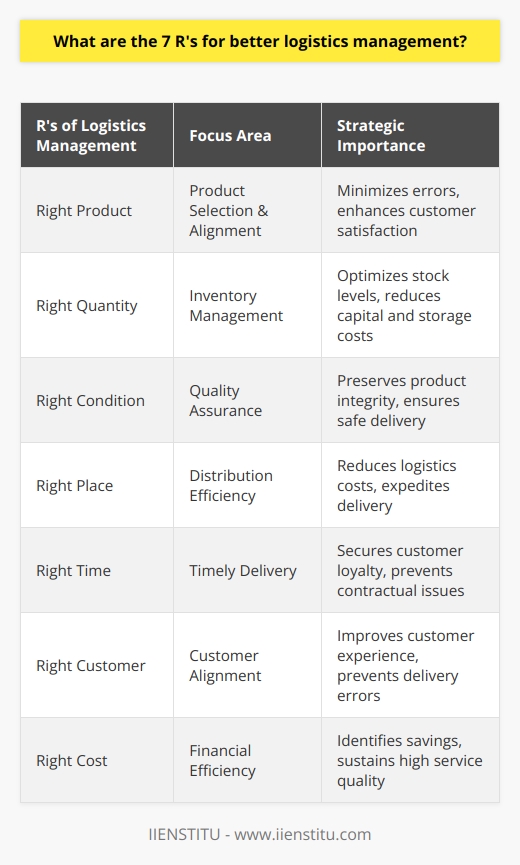
What is optimizing logistics and how can it be applied to manufacturing operations?
Defining Optimization in Logistics
Optimizing logistics refers to the process of enhancing the efficiency and effectiveness of supply chain operations to achieve a specific goal, such as reducing costs or improving customer satisfaction. This strategic approach involves analyzing various aspects of supply chain systems, such as transportation, warehousing, and inventory management, to identify and implement improvements.
Application in Manufacturing Operations
Effective logistics optimization can significantly benefit manufacturing operations by reducing lead times, enabling cost-saving measures, and improving overall production capacity. Below are several ways to optimize logistics within manufacturing operations.
Streamlined Transportation
Efficient transportation plays a crucial role in optimizing logistics. Streamlined transportation strategies can improve the speed, reliability, and cost-efficiency of delivering raw materials to production facilities or finished goods to customers. Improved transportation strategies may involve route optimization, consolidating shipments or adopting advanced transportation management software.
Inventory Management
Effective inventory management forms the backbone of supply chain optimization. By using inventory control techniques, such as Just-In-Time (JIT) or Economic Order Quantity (EOQ), manufacturing operations can achieve an ideal balance between meeting customer demand and minimizing inventory costs. This balance reduces stock obsolescence risks and improves cash flow.
Tecnological Integration
Manufacturing operations can benefit from technology integration in their logistics optimization efforts. The utilization of advanced technologies, such as warehouse management systems (WMS), RFID tracking, or automated guided vehicles (AGVs), can help improve warehouse efficiency and reduce manual handling errors. By incorporating technology into logistics processes, manufacturers can achieve more accurate data collection, enhanced traceability, and improved inventory visibility.
Supplier Collaboration
Collaborating with suppliers can lead to significant improvements in logistics efficiency. By actively engaging with suppliers in joint planning, sharing data, and aligning objectives, manufacturing operations can reduce lead times, lower costs, and improve the overall quality of raw materials. A close relationship with suppliers fosters a more transparent supply chain and enables faster, more responsive decision-making.
Continuous Improvement
Lastly, continuously monitoring performance metrics and implementing continuous improvement programs is essential in optimizing logistics. The use of key performance indicators (KPIs) can help identify areas where further improvements can be made. Regularly reviewing KPIs and acting upon insights allows manufacturing operations to swiftly adapt to new challenges, maintain competitiveness, and achieve a higher level of optimization across the logistics network.
In conclusion, optimizing logistics within manufacturing operations involves the strategic enhancement of multiple elements, including transportation, inventory management, technology integration, supplier collaboration, and continuous improvement. By implementing these optimization strategies, manufacturing operations can reduce costs, improve efficiency, and ultimately increase the effectiveness of their supply chain.
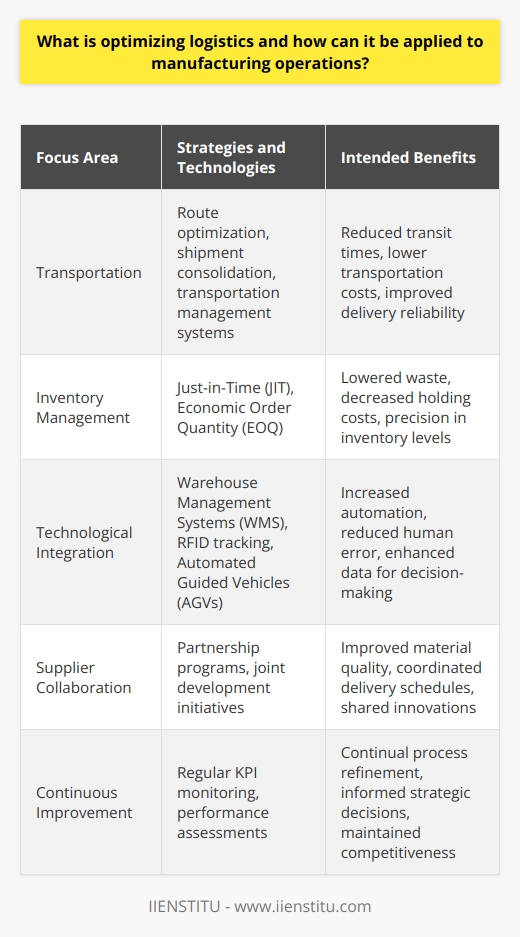
What are the 5 most commonly known principles to improve logistics, and how do they contribute to a more efficient manufacturing system?
Demand Forecasting and Planning
The first principle is demand forecasting and planning, which involves predicting the volume of products that customers will require in the future. Accurate predictions enable manufacturers to allocate resources effectively, reducing waste and costs.
Centralized Procurement Management
Next, centralized procurement management is essential for optimizing logistics. By consolidating purchasing decisions across the organization, businesses can negotiate better prices, streamline supply channels, and avoid duplication of effort.
Effective Inventory Management
Thirdly, effective inventory management is key to improving logistics. By monitoring stock levels closely and implementing policies such as just-in-time (JIT) production or demand-driven material requirements planning (DDMRP), manufacturers can minimize storage costs and avoid stock shortages, ultimately increasing efficiency.
Seamless Integration of Technologies
The fourth principle focuses on the seamless integration of technologies in the logistics process. Adopting technology solutions, such as warehouse management systems (WMS), transportation management systems (TMS), and enterprise resource planning (ERP) systems, can automate tasks, reduce errors, and improve overall visibility of the supply chain.
Continuous Process Improvement
Lastly, embracing continuous process improvement is vital for any efficient manufacturing system. Employing methodologies like Lean Manufacturing, Six Sigma, and Total Quality Management (TQM) can help manufacturers identify and address inefficiencies, ultimately driving improvement in logistics performance.
In summary, the five key principles of improving logistics - demand forecasting and planning, centralized procurement management, effective inventory management, seamless integration of technologies, and continuous process improvement - contribute to a more efficient manufacturing system by optimizing resource allocation, minimizing costs, reducing waste, and increasing overall productivity.
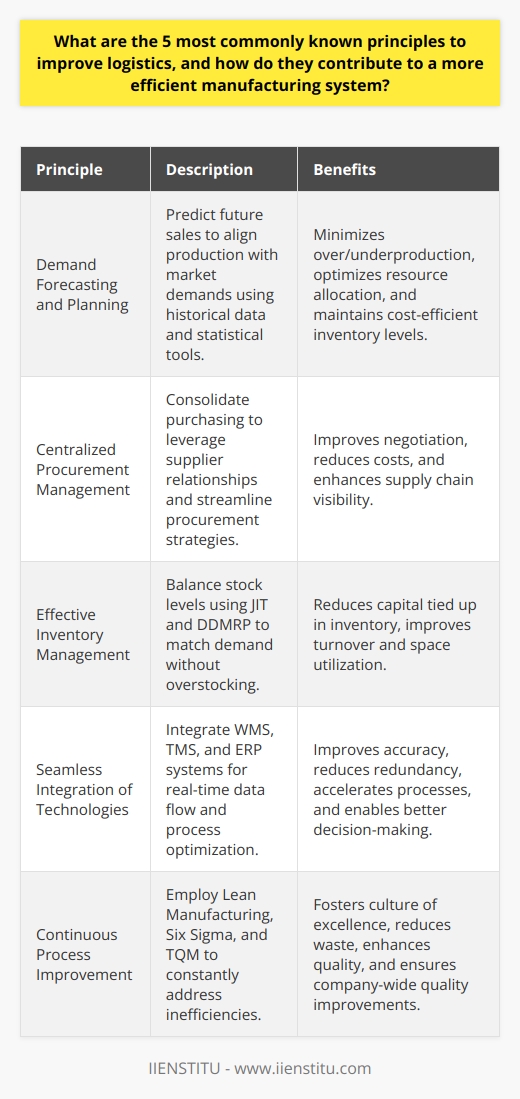
What are the key factors in implementing successful manufacturing logistics management?
Essential Elements of Manufacturing Logistics Management
Efficient Supply Chain Design
A crucial factor in implementing successful manufacturing logistics management is designing an efficient supply chain. The supply chain's structure should be strategically planned, taking into account elements such as procurement, production, storage, transportation, and delivery of final products. It ensures an optimal flow of materials, minimizes disruptions, and lowers costs while maintaining product quality and customer satisfaction.
Inventory Optimization
Another key aspect of effective logistics management is inventory optimization. This involves accurately forecasting demand, setting appropriate inventory levels, and implementing just-in-time (JIT) strategies to reduce excess stock. By doing so, manufacturers can avoid stockouts, overstocking, and wasted resources, thus maximizing profitability and responsiveness to changing market conditions.
Technology Integration
Modern manufacturing logistics management requires the integration of advanced technology. Adopting a robust warehouse management system (WMS), implementing automation technologies such as robotics, and utilizing data analytics and artificial intelligence (AI) can greatly improve efficiency and reduce human error. Furthermore, employing real-time tracking systems ensures better visibility and control over all aspects of the supply chain.
Lean Manufacturing Principles
The application of lean manufacturing principles is vital to successful manufacturing logistics management. These principles focus on eliminating waste, reducing lead times, and improving process efficiency. Adopting lean practices such as continuous improvements, value stream mapping, and root cause analysis can significantly enhance manufacturing logistics management by streamlining operations and reducing costs.
Collaborative Relationships
Establishing and maintaining collaborative relationships with suppliers, carriers, and customers is another essential facet of manufacturing logistics management. By fostering open communication, information sharing, and mutually beneficial agreements among all parties, manufacturers can achieve more efficient and agile supply chains. In addition, adopting collaborative strategies like vendor-managed inventory (VMI) and strategic alliances can further smoothen the flow of materials and information across the supply chain.
Risk Management and Contingency Planning
Lastly, effective manufacturing logistics management involves identifying, analyzing, and mitigating potential risks such as supply chain disruptions, natural disasters, and political instability. Manufacturers must develop contingency plans to ensure the continuity of operations and a rapid response to any emerging issues. Risk management strategies such as supply chain diversification, proactive monitoring, and flexible transportation options contribute to the overall success of manufacturing logistics management.

How do different stages of the supply chain interact within the context of manufacturing logistics optimization?
Supply Chain Stages Interaction
In the context of manufacturing logistics optimization, the different stages of the supply chain, such as procurement, production, warehousing, transportation, and distribution, interact closely with one another to ensure the efficient flow of goods along the entire chain. This interaction is essential for effectively managing resources, minimizing operating costs, and maintaining exceptional customer service.
Procurement and Production
The first interaction occurs between procurement and production stages. The procurement department is responsible for acquiring raw materials and components, which are utilized by the production department to manufacture finished goods. Accurate forecasting and communication between these two stages are crucial to ensure the right quantities of materials are purchased and produced.
Warehousing and Transportation
Another vital interaction happens between warehousing and transportation. Warehouses are responsible for storing both raw materials and finished products awaiting transportation. Effective inventory management practices, such as just-in-time and lean inventory, can minimize carrying costs while ensuring the timely delivery of goods to customers.
Transportation and Distribution
Lastly, transportation and distribution stages interact to deliver goods from the manufacturer to the end consumer. Quality transportation systems ensure that deliveries are made on time, reducing lead times and improving customer satisfaction. On the other hand, effective distribution channels help in the efficient movement of goods to different market segments.
Logistics Optimization Techniques
The alignment between different supply chain stages is accomplished through the implementation of logistics optimization techniques. Such strategies include collaborative planning, forecasting, and replenishment (CPFR) to enhance cooperation among supply chain partners, reducing lead times, and improving overall performance.
Data-Driven Decision-Making
Data-driven decision-making plays a significant role in the interaction and performance of different supply chain stages. Utilizing advanced analytics tools and supply chain management software helps in identifying inefficiencies, predicting demand patterns, and optimizing resources allocation throughout the entire chain.
In summary, the interaction between various stages of the supply chain is crucial for the successful optimization of manufacturing logistics. To achieve this, companies need to adopt effective inventory management techniques, implement supply chain collaboration strategies, and leverage data-driven insights to improve efficiency and customer satisfaction across all stages of the supply chain.

What are the best practices in utilizing technology and innovation for enhancing logistics management in the manufacturing process?
Role of Technology and Innovation in Logistics Management
One of the best practices in utilizing technology for enhancing logistics management is leveraging big data analytics. Big data allows manufacturers to identify trends, optimize operations, and improve decision-making, ultimately leading to better supply chain efficiency. Integrating various data sources, including shipment tracking, warehousing operations, and transport metrics, can help businesses refine their logistics processes and achieve optimum performance.
Automation for Enhanced Productivity
Another vital practice is the implementation of automation technologies, such as autonomous vehicles and robotics, in the manufacturing process. These technologies can streamline material handling, reduce human error, and ensure faster and consistent operations. For instance, automated guided vehicles (AGVs) can transport materials between various stages of manufacturing with minimal supervision, ultimately enhancing the overall efficiency of logistics management.
IoT for Real-Time Information
Incorporating the Internet of Things (IoT) in logistics practices can enable real-time monitoring and control of the supply chain. IoT sensors can track the movement and status of goods throughout the manufacturing process, enhancing visibility and reducing the likelihood of delays. Additionally, manufacturers can monitor equipment performance and identify potential maintenance issues, minimizing the risks of equipment breakdowns, and disrupted operations.
Cloud-Based Solutions for Remote Collaboration
Utilizing cloud-based platforms for logistics management can ensure seamless communication, information sharing, and collaboration among various stakeholders. A centralized, cloud-based system provides instant access to critical data, enabling businesses to act on any changes or disruptions in the supply chain promptly. Moreover, these platforms facilitate scalability and easy access to valuable information from any location, promoting effective decision-making and improved logistics management.
Utilizing Machine Learning to Optimize Operations
Implementing machine learning algorithms in logistics management can help organizations predict and optimize future demands and requirements. By analyzing historical data on customer demand, production schedules, and shipment volumes, machine learning tools can estimate future trends and capacity needs. This predictive intelligence ensures that businesses can manage resources, minimize costs, and mitigate risks more efficiently.
Conclusion
In summary, incorporating advanced technologies and innovations, such as big data analytics, automation, IoT, cloud-based platforms, and machine learning, in logistics management practices can significantly enhance information flow, decision-making, and efficiency in the manufacturing process. Adopting these technological solutions will ultimately enable businesses to optimize operations, reduce costs, and increase overall competitiveness in the market.
